This week sees me making good progress on my lanterns.
Basically, now that I have established the style, shapes, sizes, templates and patterns of the lanterns, I have been doing lots of tracing, cutting and assembling (as can be seen below)!
To begin the assembly of my lanterns, I take the cut-out shape (which already has my laser printed pattern on it) and begin by folding the tab in. I want the pattern to be on the inside of the tertrahedral, so it will be visible when the whole lantern is assembled.
Once the tab is tucked under, it is folded in half, so all the corners meet.
Then open it up again and fold the two outside bits in to meet the middle fold. This gives you the four even sides of the tetrahedral.
Then four small slits are made in the top.
These are then folded in. They act as small tabs which help to hold the globes in place once pushed through the top of each little lantern.
Double-sided tape then goes onto the tab.
Then the four sides are sealed.
And one of the components of the whole lantern is completed!
Now to continue on making another 20 (as the design seems to comfortably fit 21 tetrahedrons as opposed to 18 as initially thought)!
Now to continue on making another 20 (as the design seems to comfortably fit 21 tetrahedrons as opposed to 18 as initially thought)!
***
My fiancé and I have been able to perfect the lights, so the wiring is not even seen when the lantern is complete, it is all contained within the paper structure.
I have also created a slight variation to my current tetrahedral template to make a smaller, more ‘star-like’ lantern to compliment my existing larger ones.
I am now thinking of hanging 4 lanterns in a cluster consisting of two larger ones and two smaller star-like ones. Only one large one and one small one will be lit (due to cost and time restraints).






















